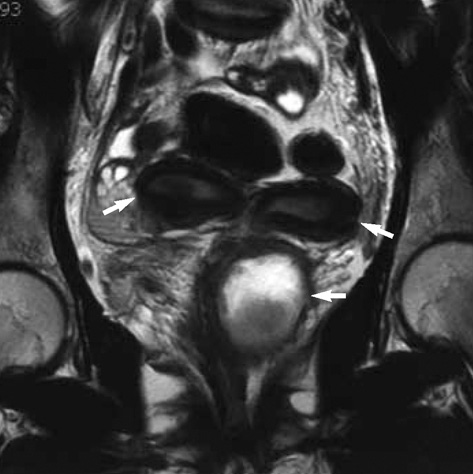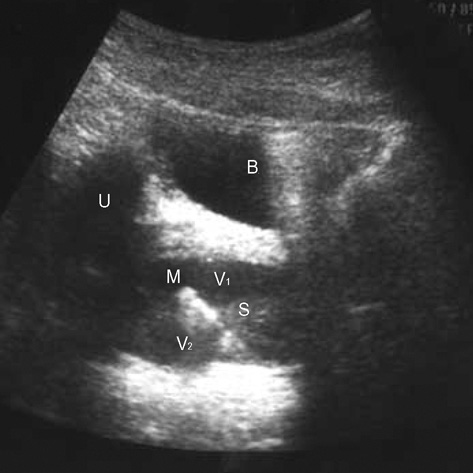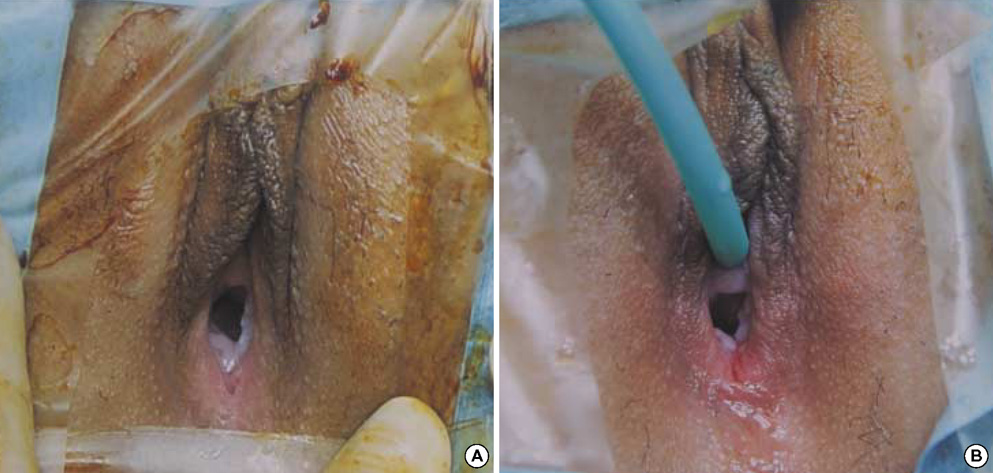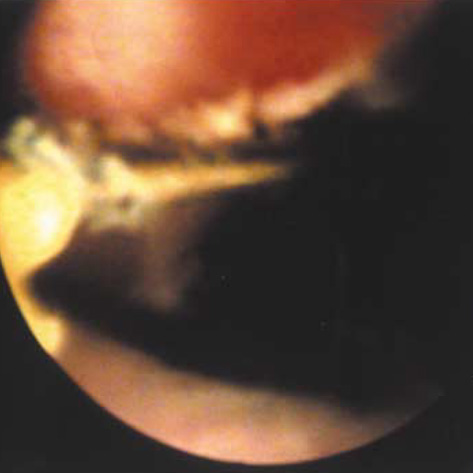J Korean Med Sci.
2007 Aug;22(4):766-769. 10.3346/jkms.2007.22.4.766.
Hysteroscopic Resection of the Vaginal Septum in Uterus Didelphys with Obstructed Hemivagina: A Case Report
- Affiliations
-
- 1Department of Obstetrics & Gynecology, The Institute of Reproductive Medicine and Population, Medical Research Center, Seoul National University College of Medicine, Seoul, Korea. ymchoi@snu.ac.kr
- 2Department of Obstetrics and Gynecology, Graduate School of Medicine, Gachon University of Medicine and Science, Incheon, Korea.
- KMID: 1127104
- DOI: http://doi.org/10.3346/jkms.2007.22.4.766
Abstract
- Uterus didelphys with obstructed hemivagina and ipsilateral renal agenesis is a rare congenital anomaly. Excision of the obstructed vaginal septum is the treatment of choice for symptom relief and the preservation of reproductive capability. A 14-yr-old girl complained of persistent vaginal spotting following each menstruation. Pelvic magnetic resonance imaging revealed a uterus didelphys with left hematocolpos and ipsilateral renal agenesis. Instead of conventional transvaginal excision of the vaginal septum, we used hysteroscopic excision under transabdominal ultrasonographic guidance to preserve the integrity of the hymen. The postoperative course was uneventful, and clinical symptoms were completely resolved after this intervention. Resectoscopic excision of the vaginal septum was found to be easy, safe, effective, and appropriate for young women as it preserved hymen integrity. We believe that this is the first Korean report on the use of a hysteroscopy for vaginal septum resection in a patient with uterus didelphys with obstructed hemivagina.
Keyword
MeSH Terms
Figure
Reference
-
1. Burgis J. Obstructive Mullerian anomalies: case report, diagnosis, and management. Am J Obstet Gynecol. 2001. 185:338–344.2. Prada Arias M, Muguerza Vellibre R, Montero Sanchez M, Vazquez Castelo JL, Arias Gonzalez M, Rodriguez Costa A. Uterus didelphys with obstructed hemivagina and multicystic dysplastic kidney. Eur J Pediatr Surg. 2005. 15:441–445.
Article3. Gilsanz V, Cleveland RH, Reid BS. Duplication of the Mullerian ducts and genitourinary malformations. Part II: analysis of malformations. Radiology. 1982. 144:797–801.4. Rock JA, Breech LL. Rock JA, Thompson JD, editors. Surgery for anomalies of the Müllerian ducts. Te Linde Operative Gynecology. 2003. 9th ed. Philadelphia: Lippincott Williams & Wilkins;746–748.5. Tsai EM, Chiang PH, Hsu SC, Su JH, Lee JN. Hysteroscopic resection of vaginal septum in an adolescent virgin with obstructed hemivagina. Hum Reprod. 1998. 13:1500–1501.
Article6. Cicinelli E, Romano F, Didonna T, Schonauer LM, Galantino P, Di Naro E. Resectoscopic treatment of uterus didelphys with unilateral imperforate vagina complicated by hematocolpos and hematometra: case report. Fertil Steril. 1999. 72:553–555.
Article7. Zurawin RK, Dietrich JE, Heard MJ, Edwards CL. Didelphic uterus and obstructed hemivagina with renal agenesis: case report and review of the literature. J Pediatr Adolesc Gynecol. 2004. 17:137–141.
Article8. Rock JA, Jones HW Jr. The double uterus associated with an obstructed hemivagina and ipsilateral renal agenesis. Am J Obstet Gynecol. 1980. 138:339–342.
Article
- Full Text Links
- Actions
-
Cited
- CITED
-
- Close
- Share
- Similar articles
-
- A Case of the Uterus Didelphys with Unilateral Obstructed Hemivagina
- A Case of Hysteroscopy Assisted Therapeutic Abortion of Pregnancy in a Side of Uterus Didelphys Affected with Obstructed Hemivagina
- 2 Cases of Uterus Didelphys with Unilateral Obstructed Hemivagina and Ipsilateral Renal Agenesis
- A case of the uterus didelphys with unilateral obstructed hemivagina and ipsilateral renal agenesis
- 3 Cases of Uterus Didelphys with an Obstructed Hemivagina and Ipsilateral Renal Agenesis





